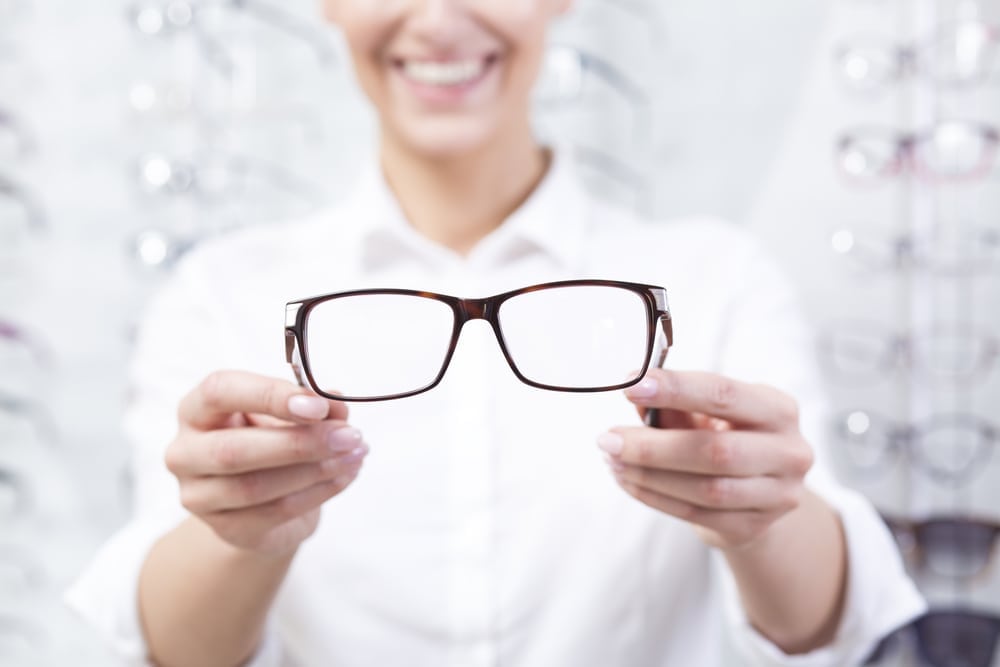Myopia
Myopia is a refractive error that causes nearsightedness and blurred vision when looking at a distance. The condition is very common, affecting approximately 30 percent of the total U.S. population. The condition usually develops in childhood and gradually worsens throughout adolescence. In some cases, people develop myopia after Myopia is easily diagnosed with a comprehensive eye exam and corrected with various treatments, including glasses, contact lenses or refractive surgery.
Hyperopia
Hyperopia is a refractive error that causes farsightedness and blurred vision when looking at objects up close. Approximately 1 in 2 people has some degree of hyperopia, which may also cause headaches and eyestrain. Hyperopia is typically genetic and usually develops in childhood. The condition is easily diagnosed during a comprehensive eye exam and treated with glasses or contacts.
Astigmatism
Astigmatism occurs when the eye’s natural lens becomes misshapen. There can be varying degrees of corneal astigmatism, which often occurs in people with other vision impairments, such as myopia and hyperopia. Astigmatism is very common, causing blurry or distorted vision, as well as the potential for headaches or eye strain. A optometrist can diagnose astigmatism during a standard eye exam and prescribe treatment, such as glasses or contacts, to help treat it.
Amblyopia
Amblyopia is a condition in which the brain only one eye instead of both. Also known as ‘lazy eye’, this condition only develops in children and may cause vision loss and other conditions, such as crossed eyes. Usually, a child will develop amblyopia no later than age 6, though it may appear much sooner than that. Your optometrist can diagnose amblyopia during a comprehensive eye exam. A child with ‘lazy eye’ will need to wear prescription lenses and may need vision therapy to help treat the condition.
Presbyopia
Presbyopia is a refractive error in which the eye is no longer capable of focusing correctly. It is primarily age-related and occurs in all people – usually sometime after age 40. Presbyopia is a not a disease though it can make reading and viewing objects up close much more difficult. A comprehensive eye exam can evaluate visual acuity and diagnose presbyopia. Often, patients only require reading glasses to manage the problem, though prescription bifocals, trifocals or contact lenses may be necessary for some people.
Emmetropia
Emmetropia is the term used to describe an eye with normal vision strength, curvature and eyeball length. People with emmetropia require no corrective lenses, as images come into natural focus on the retina.
Macular degeneration is a disease in which the macula weakens, resulting in a loss of central vision. The condition, also known as age-related macular degeneration (AMD), can cause blurring and even partial vision loss. There are two types of macular degeneration – wet and dry. Most people with the disease have the latter version, which is caused solely by an aging macula. However, some people have wet macular degeneration, which occurs when abnormal blood vessels grow inside the macula. The wet version can lead to permanent scarring and loss of central vision.
Did you know…
that macular degeneration is one of the leading causes of vision loss in America? Currently, there are approximately 1.8 million adults over age 40 who have macular degeneration – most of whom are seniors ages 75 and up. Even more – 7.3 million – are currently considered at high risk of developing the disease. In fact, the Centers for Disease Control estimates the prevalence of macular degeneration to grow, reaching nearly 3 million by the year 2020.
Frequently Asked Questions
Who is at risk for developing macular degeneration?
Age is the most influential risk factor for developing macular degeneration, though the disease is also common in Caucasians, and people who smoke. The symptoms of metabolic syndromes such as obesity, high blood pressure, and high cholesterol, can also increase the risk of developing macular degeneration.
What are the symptoms of macular degeneration?
In most cases, the symptoms of macular degeneration begin gradually and progress slowly over time. People often describe having blurry vision or blind spots, as well as difficulty perceiving color. Anyone who is experiencing unusual vision changes should schedule an optometry appointment. A routine eye exam can identify AMD in its earliest stages, which may improve long-term management of the disease.
What is the treatment for macular degeneration?
There is no cure for macular degeneration although an optometrist can help manage the condition. People with AMD may benefit from certain nutritional supplements like zinc and beta-carotene, as well as certain drug therapies as the disease becomes more advanced. Wet macular degeneration often requires greater interventions, which may include laser therapy to target and destroy abnormal blood vessels in the eye.

